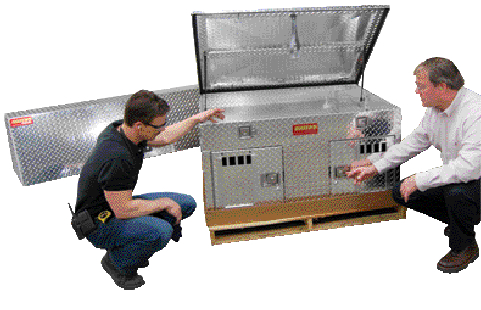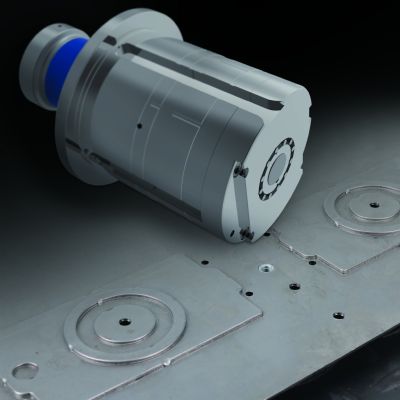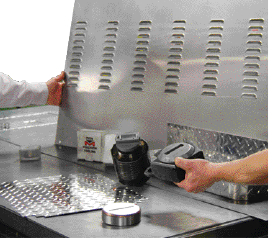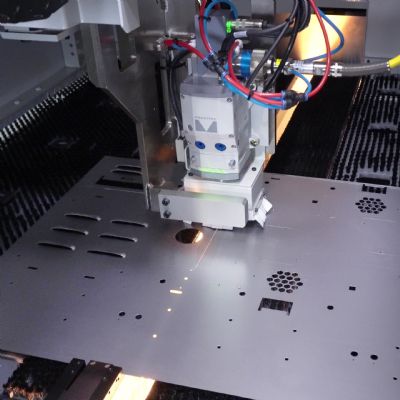Punch Performance Earns Applause
September 1, 2010Comments

Owens Products fabricates dog boxes of heavy-duty diamond tread aluminum. “Punched parts are highly visible in the finished product,” says plant manager Joe Long (left), “so punched features must show well. And, the components are assembled and welded together, so sheared and punched parts must be flat and precise. We can’t tolerate uneven, rough edges or burrs.” Shown here along with Long, inspecting a fabricated dog box, is Mate sales engineer Gary Troxell.
How is it possible to make millions of punch hits without having to replace tooling , and with very little maintenance, over a span of seven years of fabricating sheetmetal parts? And, more importantly, what impact does that kind of punch-press tool life have on productivity and the bottom line?
Certainly Owens Products knows the answers to those questions, where fabricating made-to-order sheetmetal products means punching a lot of short runs. Many of the company’s products are comprised of just six or seven punched components, and with many products and variations, there is frequent changeover in the turret press from one product to the next.
The key to maximum productivity for these short runs is to punch quickly, moving from job to job and minimizing setup time. Especially important is tool life, so that tools stay sharp and the turret press keeps punching without interruption for tool sharpening or replacement.
Better Punching Means Lean Fabricating
Owens Products, Sturgis, MI, is well known for its sleek running boards designed for pickup trucks, vans and SUVs; it also manufactures vehicle toolboxes and elegant dog boxes. With a commitment to only the highest quality fabricating, this family owned business has grown steadily for more than 40 years.
One of the keys to Owens Products’ success is a well-managed punching operation in a lean-manufacturing environment.
“Nearly all of our products are fabricated from diamond-tread aluminum and galvanized steel,” says plant manager Joe Long. “We punch primarily Type 3003 aluminum sheet 0.056 to 0.10 in. thick, as well as 12- and 16-gauge galvanized steel, running sheet sizes from 48 by 48 to 48 by 96 in. In addition to shearing parts for these products on our turret presses, we also form, emboss and punch louvers.”
Long, describing how important fitup and punched features are in these components, adds: “These punched parts are highly visible in the finished product, so punched features must show well. And, the components are assembled and welded together, so sheared and punched parts must be flat and precise. We can’t tolerate uneven, rough edges or burrs. The punch-press tooling we’ve been using (fully guided Marathon tools from Mate Precision Tooling) not only provides the necessary quality, but also delivers outstanding tool life. We’re still using the shearing tools that we bought 7 yr. ago for our daily punching operations. They’ve never cracked or chipped, and rarely need sharpening.”
Moving Metal by the Ton
Owens Products punches 9000 lb. of sheetmetal every week, averaging 550 steel parts and 100 aluminum parts per 8-hr. work day. “That’s a lot of parts when you consider lot sizes are small,” adds Long, “often from just one or two parts per order to as many as a dozen. That’s a lot of tool changes.”
The firm operates a Murata Wiedemann Motorum 2044EZ press at a 100-percent feed rate for shearing operations, equal to 220 hit/min; nibbling operations run at 600 hits/min. “That’s very near top speed for the press,” says Long, “putting a heavy burden on the tooling and the machine.”
The press runs a servo-driven ram, making high-speed and low-noise punching possible by controlling acceleration and deceleration of the ram drive and by controlling ram power, all during the punch stroke. This servo hydraulic design, when outfitted with the Mate Marathon tooling, makes for high precision processing with accuracy to ±0.1 mm.
Designed specifically for Murata presses, the Mate tool system features punches fully guided by a metal stripper contained within punch holders. The combination of the punch and guided stripper optimizes punch-point stability, eliminating part damaging saw-toothing, which adds stress and wear to the tool components. The result is precise, smooth tool-to-workpiece contact that ensures sheet flatness, “very important to the quality of our products,” adds Long, “even when producing closely located holes.”
The punches are produced from specially formulated and controlled M-2 high-speed steel to offer good wear resistance while maintaining accuracy in shearing parts and punching accurate holes at high press speeds. Their near polished punch flanks and minute back taper reduce friction of the tool components, eliminating punch build-up (galling) and improving stripping, while extending tool life.
The tooling also has a unique twist-and-click stripper mechanism that allows rapid tool changes without using tools. “Our press operators can set the optimum tool length by hand without shims, gauges or calipers, simply by adjusting the integral length adjustment mechanism,” says Long. “This is very important with our short runs for maximum machine uptime and productivity.”
Operators Hit the Snooze Button on Tool-Life Alarm
Relaying one specific experience with the tooling, Long describes use of a 0.2 by 2.8-in. parting tool. “We use that tool to cut straight lines for parts that need assembly and welding along the edges,” he says. “The tool has a roof-top shear, allowing less tonnage and punching force to penetrate the material cleanly. We’ve put several million hits on that tool (and several others) without having to resort to the tool grinder. When the press tool alarm reminds us to check the tool for chipping and wear (every 500,000 hits), our operators go ahead and inspect the tool and, without fail, go ahead and reset the alarm and run another half million hits.”
Summarizing the fabrication-shop success with the tooling, Long adds: “The efficiencies we’ve experienced with the prolonged tool life comes via the cost savings from no lost time due to tool damage and not having to replace tooling due to short life span. How many hits does it take to wear out these punches? We may never know.” MF
Article submitted by Mate Precision Tooling, Anoka, MN: 763/421-0230; www.mate.com.View Glossary of Metalforming Terms
See also: Mate Precision Tooling
Technologies: CNC Punching
Comments
Must be logged in to post a comment. Sign in or Create an Account
There are no comments posted. CNC Punching
CNC PunchingCNC Punching: Positive Stop a Positive Advantage
Lou Kren Monday, February 27, 2023








